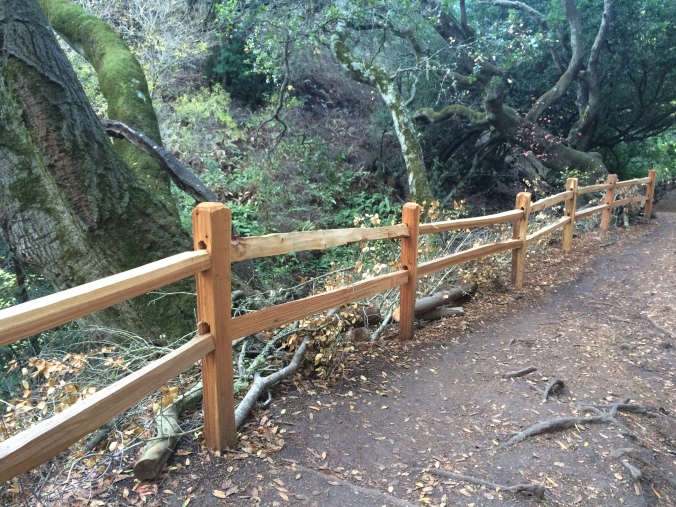For those of us who love the peace and inspiration of a long walk in the wild, it’s hard to imagine that our very presence could be actively harming the ecosystems we’re supposedly communing with. It’s anathema to our entire philosophy as lovers of the outdoors. But it is increasingly being shown that our presence-each footfall, each brushing of a branch, each stream crossing-actively harms the organisms around us and reduces ecological function. That damage exists on a continuum, of course, but we all need to come to terms with our impact, and the responsibility we have to compensate for it.
On a trail near where I live, a trail where I have helped restore habitat, a rogue hiker- or hikers- have been maintaining a bootleg trail (a trail not planned or sanctioned by the park district) by breaking tree branches, moving natural debris, and trampling vegetation. When rangers tried to discourage use by posting advisory signage and blocking the trail with large branches, the hiker(s) responded by destroying the signs and pushing the blockages out of the way. Someone even sawed down a young redwood tree. These are people who have gone out of their way to enjoy their local regional park. What could possibly motivate them to destroy it?

Fencing is a message to stay on trail, not an invitation to go beyond it.
In a recent article in Outside Online, author Christopher Solomon describes the palpable conflict between recreational uses and conservation mandates in public wild areas. Our ethic of conservation is built largely around the creation and maintenance of natural areas for public use; it’s built into the funding structures that support parks and the missions of the agencies that set aside and maintain them. This may foster the belief that these public lands are all ours, and therefore we can go wherever, and do whatever, we please within their borders.
But that approach doesn’t work as a conservation ethic. Solomon writes,
“When we play in the mountains and forests, we think we’re simply having fun. (Leaving no trace! Communing with nature!) But whether we’re in closed or open areas, studies show that even Sierra Club-approved activities like hiking, cross-country skiing, and bird watching can negatively affect the environment more than you’d think. Take research in Boulder that discovered a roughly 100-yard “death zone” for songbirds on both sides of a trail, as one scientist put it, pointing to low nesting success and lower populations. Moose increased their movement by 33 percent, burning more energy, after encountering skiers, a study in Scandinavia found. In one not-yet-published survey of 218 studies that looked at the effects of recreation on wildlife, researchers found more evidence for impacts by non-motorized activities than by motorized ones.”
Based on what I’ve seen on my local trail, I believe it. People who use this trail believe that they- and their off-leash dogs- have the right to use the trail and any area around it however they please. They blatantly ignore signage asking them to keep their animals out of the stream to protect native fish, frogs, and newts. They believe they are entitled to create trails wherever they wish, no matter what those who are tasked with maintaining the park say. How is this responsible appreciation of our natural resources?
If we are to approach a sustainable balance with our rapidly deteriorating ecosystems, we must give up the misguided belief that our presence does no harm, and that we are entitled to use natural areas however we please. Especially in massively overpopulated areas like California, there is just not enough habitat left to sustain healthy wildlife populations. Solomon concludes: “As a recreation community, we should not only be prepared to accept… restrictions—we should also embrace and support them, if science tells us they work.”
Regional, state and federal land management districts go to enormous effort to study, understand and plan for the proper management of ecosystems in public areas. The very least that park users can do to honor that effort, and the wild places that we enjoy so much, is to respect boundaries and give nature some space.
It’s frustrating when people intentionally destroy things that were well intended. I agree wholeheartedly that sometimes we need to give nature space.
LikeLike
Sure is, Josh. And there’s no easy solution, but we have to work together to protect the sacred wilderness experience while allowing wildlife the space it needs to survive and thrive. Thank you for reading!
LikeLike
I’ve seen this similar problem down in the tropics with tourist damage to coral reefs. Even when ecotourism is the stated goal, clumsy divers or pollution from boats make highly visited reefs more degraded then ones set aside for conservation where visitors are barred. Maybe the best approach would be to have one or two “sacrificial” reefs or trails in a park, where human degradation is tolerated to allow people to experience and connect with nature (after all, that’s how you get people to care about the natural world). By reserving set areas for human use, the larger ecosystem can be protected. Of course such conservation zoning is easier for a coral reef where supervised divers can’t wander far; whole different ballgame for hiking trails in a national park
LikeLike